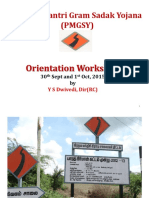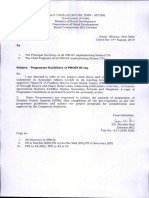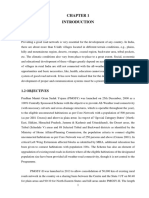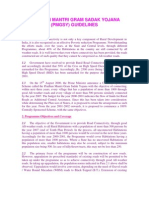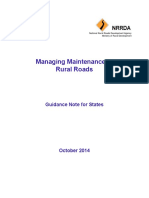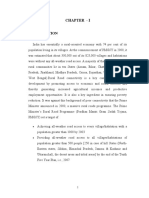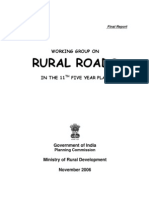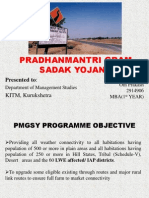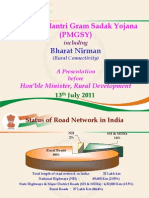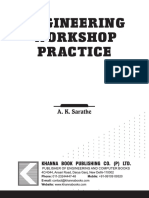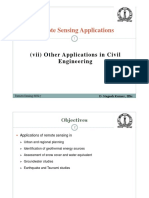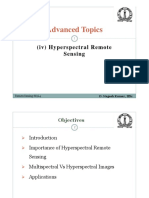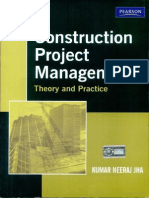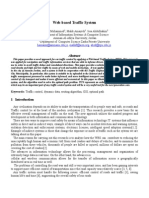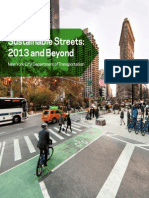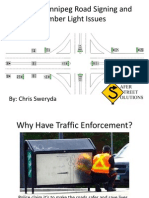National Rural Roads Development Agency
CHAPTER 4
ANNUAL PROPOSALS AND THEIR CLEARANCES
4.1 FUNDING AND ALLOCATION
4.1.1 Once the Core Network is prepared, it is possible to estimate the length of roads for New Connectivity from the
CNCP List. Similarly, after the Condition Survey in districts having no new connectivity remaining, it is possible to estimate
the length of roads required to be upgraded. States may, each year, distribute the States Allocation among the Districts
distributing atleast 80% to New connectivity Districts on the basis of ratios of road length required for providing
connectivity to Unconnected Habitations and not more than 20% to districts with no new connectivity on the basis of ratio
of road length requiring Upgradation under the PMGSY. The District-wise allocation of funds would also be communicated
by the SRRDA to the Ministry/ NRRDA and to the State Technical Agency, in order to enable the STA to scrutinize the
DPRs of the District. Depending on the extent of new connectivity backlog, absorption capacity, position of the ongoing
works etc, the State will be asked to prepare DPRs for upto twice the PMGSY allocation.
4.1.2 To ensure due primacy to new connectivity, in case only a few Districts have achieved full connectivity, it is not
necessary to distribute the entire 20% among them. A smaller percentage would suffice, based on a simple arithmetical
average of what the Districts share would be.
4.2 PROPOSALS
4.2.1 Annual proposals consisting of list of roads eligible under PMGSY are to be finalized by the District Panchayat. As
mentioned in Para 3.3.1, based on the DRRP and Core Network, a CNCP List or a CUPL is to be prepared by the PIU/
SRRDA prioritising the list of eligible road works and the annual proposal will be prepared on the basis of the List as
follows:
In States where existing rural through routes are in reasonably good condition (i.e. PCI is generally above 3) the
prioritisation of new links will be taken up for construction in the order of the CNCPL. Based on the likely value of
proposals required to be submitted, the PIU will mark off the eligible road works in the Order of Priority to the
required total value of the District allocations, applying the per km cost based on previous years cost for similar
type of work (new connectivity/ Upgradation etc).
In States where the existing rural through routes are in very poor condition (PCI is generally 3 or less) because of
neglect of maintenance, upgradation / renewal of through routes may be taken up as an adjunct to new connectivity
and the procedure will be as follows:
Step 1: Select the New Connectivity Link as per CNCPL in order of priority.
Step 2: Identify the rural Through Routes (called associated Through Route) from which the new link is taken off till
such road reaches the nearest market centre/ higher category road.
Step 3: Find out the Pavement Condition of the associated rural Through routes identified in Step 2 (from the PCI
register, See Para 14.9).
Step 4: Decide the type of intervention required based on the PCI. This implies a decision whether the roads
leading to the market centre require Upgradation or Surface Renewal or routine Maintenance. Associated Through
Routes having PCI 3 and below and 6 years or more old can be taken up for Upgradation/ Renewal. For the roads
with PCI above 3, or whose age is less than 6 years, Routine Maintenance or, if due, Renewal will be adequate,
unless there are structural / geometrical/ drainage deficiencies which need to be improved through Upgradation.
Step 5: Include all other eligible new links as per Comprehensive New Connectivity Priority List (CNCPL) coming
on to the Through Routes identified in Step 3 even if such links are lower in the Order of the Priority. These eligible
Chapter 4 http://pmgsy.nic.in/op4.htm
1 of 6 04-Jul-14 11:26 AM
new links would be the subsidiary link routes.
Step 6: Each project will thus comprise of a sub-network of a primary new connectivity link, the associated Through
Route (s) and subsidiary new connectivity links (falling on the associated Through Routes). The project proposal
will include new construction for the new links and Upgradation/ renewal of the Through Routes based on age and
PCI. Generally each such project would form a package for tendering purposes (all the packages of a particular
year would form a Batch for future maintenance purposes).
Step 7: Make a rough estimate of the project cost based on per km construction/ upgradation cost. Through Routes
and subsidiary Link routes required to be considered, are also be included while calculating the total value. Take up
additional links from the CNCP list and repeat steps 1 to 5 till the total cost of the selected projects cover the
District allocation.
In case of Districts where no new connectivity remains, only the existing rural Through Routes may need
Upgradation. In such cases the Comprehensive Upgradation Priority List (CUPL) will apply and road works will be
selected out of the CUPL in order of priority, to the extent of the District allocation.
In drawing up the annual list of the road works, it shall be ensured that the Order of Priority for New Connectivity/
Upgradation is strictly followed. The only exception (in new connectivity links) from the order of priority is in respect
of those routes of the Core Network that include the Village Panchayat Headquarters or Market Centres or other
educational or medical essential services or those which stand notified by the State Government as places of
tourist interest. In such cases, new connectivity may be taken up irrespective of the population size.
A Preliminary Survey should be done by the PIU in all cases to ascertain from the Local Panchayat that land is
likely to be available for the road work.
4.2.2 A copy of the CNCPL/ CUPL is sent by the PIU to the Member of Parliament concerned seeking his suggestions for
the annual proposals. At least 15 days time may be given. In order to ensure that the prioritisation has some reference to
the funding available, the size of proposals expected may also be indicated to the Members of Parliament while forwarding
them the List. Para 4.1 gives the basis of District-wise allocation of fund. All States should allocate the amounts
accordingly and also further distribute it Block-wise to enable lower level Panchayati Institutions and elected
representatives to indicate their choice with the requisite geographical spread. It is expected that such proposals of
Members of Parliament which adhere to the order of priority given in Paras 3.3.1 and 3.3.3 would be invariably accepted
subject to consideration of equitable allocation of funds as per Para 4.1. (See 4.2.4 below)
4.2.3 The list of proposed road works based on the above will be submitted to the District Panchayat by the PIU. The List
will clearly indicate the suggestions received from MPs and the status of eligibility. Along with the estimated cost of
construction based on line estimate, the 5 year routine maintenance estimate will also be depicted by the PIU.
The District Panchayat will be requested to indicate its approval, and in case any changes are proposed, the reasons for
such changes. The District Panchayat may hold internal consultations or take further suggestions from lower level
Panchayat institutions. A time frame may be indicated, generally about 15 days, to enable full consultation. Any
suggestions received in the meanwhile from the Members of Parliament shall also be forwarded to the District Panchayat
for taking into consideration.
4.2.4 After obtaining the approval of the District Panchayat, the PIU will prepare the MP I and MP II statements and
forward them along with the approved list to the SRRDA. While filling up the MP I and MP II formats (Formats at Annexure
4.1), the PIU will ensure that
All MPs have been duly consulted.
Proposals of MPs qualifying under the guidelines have been included in the annual proposal list. In case, for
reasons of budgetary constraints, lack of land availability or forest clearance, the District Panchayat has not been
able to approve the road work, the specific reason shall be clearly stated in MP II, as to why it is not feasible to take
up the work at the present stage.
Where the road work is relatively low in the Order of Priority, it shall specifically be mentioned as to what the
present population level of coverage is, and what the population benefited by the proposed work is, in relation to
that.
In all cases where the proposed road work is not eligible because it is not a rural road; is not the part of Core
Network, it connects an already connected habitation; it is being covered under some other programme etc, the
specific reason shall be clearly stated in MP II.
4.2.5 Since the State annual allocation is known in general terms, in the interest of speeding up the matter without
curtailing the consultative element, even before the communication of the actual allocation from the State Government, the
Chapter 4 http://pmgsy.nic.in/op4.htm
2 of 6 04-Jul-14 11:26 AM
SRRDA may initiate the process in such a way that the District Level Lists are ready by June each year, and the
consolidated State list is ready for submission after scrutiny by SRRDA by July.
4.2.6 On receipt of the District proposals list, the SRRDA will scrutinize the list to ensure that
The road works have been approved by the District Panchayat.
All the road works are part of the Core Network, follow the order of the CNCPL/CUPL as the case may be, except
where the road work is not feasible for specific and justified reasons.
In case Associated Through Route has been taken up along with a Primary New Connectivity, that all subsidiary
New Connectivities as per Core Network has been included.
The proposals of MPs have been given due consideration and MP I and MP II have been correctly filled in.
The total value of the proposal (based on the line estimate) is as per requirement.
After proposals from all the districts have been scrutinized and found to be in order, the list along with MP I & MP II will be
placed before the State Level Standing Committee. This may be done as soon as District Level allocation is available. At
that time the SRRDA shall compile and submit the MP III format. The SRRDA will also compile the likely 5 Year routine
maintenance estimate and submit the estimated amount annually required.
4.2.7 The State Level Standing Committee shall normally consider the complete proposal for the State, except that where
there is more than one Executing Agency; the matter may be taken up Agency wise. Clearance by the Committee, which
is chaired by the Chief Secretary/ Additional Chief Secretary and includes Finance Secretary as a Member is in the nature
of Administrative Approval for the works and annual maintenance (based on the line estimate) enabling the preparation of
DPRs required for obtaining project funds from the PMGSY. As such the Committee shall
Review the progress of ongoing works and ensure that the Executing Agency is progressing well in terms of speed
and quality.
Ensure that adequate contracting capacity will be available for the proposed road works.
Ensure that the proposed road works are fully in accordance with the PMGSY Guidelines.
Satisfy itself that all necessary clearances can be obtained and policy, funding and procedural issues impeding
execution are identified and resolved. In particular, the Committee shall ensure that maintenance of the rural Core
Network in general and PMGSY roads in particular are fully catered to.
Approve the budgeting of the 5 year routine maintenance fund requirement.
The Committee shall then accord its approval to the proposal. The minutes of the meeting shall be drawn, and copy
endorsed to NRRDA as well as SRRDA.
4.2.8 On receipt of the approval of the SLSC, the SRRDA shall communicate the approval to the PIUs and coordinate the
process of preparation of DPRs. It shall then:-
Hold a coordination meeting with STAs and PIUs to determine the schedule for scrutiny of DPRs of the various
PIUs. At this meeting issues of Design and DPR preparation can also be usefully discussed (See Chapter 6).
Determine the funding limits to be allowed to PIUs for preparation of DPRs/ trace cutting and communicate the
details to the Bank branches.
Monitor the progress of preparation of DPRs and ensure that necessary data on DPRs prepared is entered by the
PIU in the OMMS data base.
4.3 PREPARATION OF DPRS
4.3.1 The PIU will bear in mind the following Guidelines in preparing the Detailed Project reports in accordance with
Chapter 5 Design of this Manual :
Rural Roads constructed under the Pradhan Mantri Gram Sadak Yojana must meet the technical specifications and
geometric design standards given in the Rural Roads Manual of the IRC (IRC:SP20:2002) and also, where
required, the Hill Roads Manual (IRC:SP:48)
The choice of design and surface for the road would be determined, inter alia, by factors like traffic density, soil type
and rainfall, following the technical specifications laid down in the Rural Roads Manual (IRC:SP:20:2002). Normally
rural roads would need to be designed to carry upto a limit of 45 commercial vehicles per day (CVPD) only. All
Chapter 4 http://pmgsy.nic.in/op4.htm
3 of 6 04-Jul-14 11:26 AM
cases of design for new construction where a higher traffic is projected need detailed justification. In the case of
new construction for eligible Habitations of population below 1000 where traffic expected is likely to remain low
(below 15 CVPD), in the interest of economy, the road would generally be designed for a gravel or other unsealed
surface as provided in the Rural Roads Manual, subject to considerations of rainfall. In case of new construction to
connect Habitations with population below 500 where the projected traffic growth is likely to be very low, the
carriageway may further be restricted to 3.0 m.
Where the road passes through a Habitation, the road in the built-up area and for 50 metres on either side may be
appropriately designed preferably as a Cement Concrete Black Pavement Road or Paved with Stones, besides
being provided with side drains. Appropriate side drains and cross drainage will be provided, so that improper
drainage does not damage the road or the dwellings alongside.
Wherever locally available materials, including products like Fly Ash are available, they should be prescribed
subject to adherence to technical norms and relevant Codes of Practice.
The Rural Roads constructed under PMGSY must have proper embankment/ drainage. Adequate number of Cross
Drainage (CD) works, including cause-ways where appropriate, must be provided based on site requirement
ascertained through investigation. Minor bridges may be provided where necessary. In case the length of the bridge
exceeds 15m, a separate DPR will be prepared after site inspection jointly by the Superintending Engineer and the
State Technical Agency. In case the length of the bridge exceeds 25m, the project will be separately executed by
the engineering division of the State Government having jurisdiction and the pro rata costs beyond 25 m and
agency charges, if any, will be borne by the State Government.
In the case of Hill States, the estimates for new construction works may be prepared in 2 parts wherever
circumstances so require as under:
The first stage will consist of formation cutting, slope stabilization, protection works and drainage works. The
second stage will include the WBM layers and bituminous surface course. The second stage may be taken
up after two rainy seasons have elapsed to ensure adequate stabilization of the side slopes. The habitations
concerned will not be counted as connected till the second stage is taken up.
Where unsealed surfaces are adequate in certain conditions like low traffic, the formation cutting, slope
stabilization and protection works, complete drainage works and appropriate surface course treatment (to
ensure all weather connectivity) will all be included in the first stage and work executed. In such cases, the
habitations will be counted as connected on completion of the first stage itself, as there will be no second
stage.
4.3.2The maintenance component to be funded by the State Government out of its resources will also be provided in the
DPR. Annual Lump sum estimate will be made for the routine maintenance items specified in the Rural Roads Manual. As
such:
In case of link routes (new construction) the component shall comprise of 5 year routine maintenance.
In case of associated rural Through Routes not requiring upgradation, the component shall include 5-year routine
maintenance including one renewal as per cycle.
In case of Through Routes taken up for upgradation, 5-year routine maintenance and a renewal at the end of the
period.
The maintenance component is to be contracted out along with the new construction / upgradation, to the same
contractor. In case the Through Route is not a rural road, the same provision will apply to the Main Rural Links (MRL)
identified in the Core Network.
In respect of Hill roads, if construction is in 2 stages, the initial 5-year maintenance contracting will be done at the time of
contracting the work for the 2nd stage. Interim maintenance, clearance of slips etc., in the period between the 1st and 2nd
stage may be done departmentally.
4.3.3 The cost of preparing DPR, including investigation, survey and testing and trace cutting (in case of hill areas) will
form part of the project cost, and may be met from the funds in hand with the SRRDA subject to future book adjustment on
clearance of the proposal at such rates as may be prescribed by the Ministry / NRRDA from time to time.
4.3.4The detailed estimates will be based on the State Schedule of Rates (SSR) prepared using the Book of
Specifications and Standard Data Book published by IRC and prescribed by the NRRDA.
Chapter 4 http://pmgsy.nic.in/op4.htm
4 of 6 04-Jul-14 11:26 AM
The State Schedule of Rates (SSR) shall be published annually and used for all rural roads. The Schedule may be District
or Circle specific.
4.3.5As work commences on preparation of DPRs, the PIUs will conduct the Transect Walk (See Chapter 5), and prepare
necessary papers to obtain land, forest clearance etc. so that before road work is put to tender, the land for the road is
available.
It is the responsibility of the State Government/ District Panchayat to oversee that lands are available for taking up the
proposed road works. A certificate that Land is available must accompany the proposal for each road work. It must be
noted that the PMGSY does not provide funds for Land Acquisition. However, this does not mean that acquisition cannot
be done by the State Government at its own cost. The State Government may also lay down guidelines for voluntary
donation, exchange or other mechanisms to ensure availability of land. The process of making land available for the road
works should sub-serve the common good and also be just and equitable. The details of land made available should be
reflected in the local land records to avoid dispute. As far as possible, voluntary donations should be documented through
agreements, copy of which should be forwarded to the local revenue officials for making necessary changes in the
ownership/ possession record of the land. Specimen of such an agreement is at Annexure 4.2 and 4.3. The States may
adopt the appropriate format.
4.4 ENTRY OF DPR DATA ON OMMS
After DPR has been prepared (See Chapter 5) based on soil survey to estimate CBR, and traffic expected (to estimate
Annual Average Daily Traffic or AADT), the essential data of the DPR is to be entered by the PIU after logging into the
Proposals module of OMMS. The following essential data has to be entered:
Name of the road (selected from DRRP/Core Network) along with road and habitation data.
The CBR, AADT values and the design curve being used as per Rural Roads Manual.
The type of pavement, pavement and CD Costs.
Year- wise 5 -year routine maintenance cost estimate etc.
Road construction history and PCI values in case of upgradation of Through Routes.
The STA will scrutinize only such DPRs whose data have been correctly and completely entered in OMMS. (See Chapter
7).
4.5 SCRUTINY BY STATE TECHNICAL AGENCY
The STA will scrutinize each DPR after checking that it has been entered in the proposals module of OMMS. Detailed
procedure for scrutiny is given in Chapter 7. After scrutiny, the STA will clear the DPR, make confirmatory entries in the
OMMS data for the DPRs and return the DPR documents duly certified and countersigned. In case OMMS data is
incomplete or changes are required as a result of the scrutiny, the STA will ask the PIU to make the changes and verify
that they have been made before countersigning the DPRs. The PIU will forward the DPRs to the SRRDA after ensuring
that the STA has made the confirmatory entry in the OMMS.
4.6 FORWARDING OF ANNUAL PROPOSALS
After scrutiny is complete, the SRRDA will intimate the NRRDA of its readiness to forward the proposals for clearance of
the Ministry under PMGSY.
The SRRDA shall send to NRRDA the following information along with the check list (Annex. 4.5) for the purpose:
Status of Core Network.
Certificate for Maintenance by State Government.
Status of Connectivity (District-wise).
Status of ongoing PMGSY projects.
Status of Quality Control Monitoring.
Status of OMMS.
Details of proposals for the current year.
Cost of projects (Construction and Maintenance).
Proceedings of the State Level Standing Committee clearing the proposals.
Capacity and institutional readiness for the projects.
Annexure 4.4 gives the prescribed formats.
Chapter 4 http://pmgsy.nic.in/op4.htm
5 of 6 04-Jul-14 11:26 AM
4.7 UPLOADING OF TENDER DOCUMENTS
After compilation of DPRs by PIU, the PIU will prepare the bidding document for every package as detailed in Para 8.6.
The above details will be filled up into the Draft Tender Document module of OMMS and draft bidding document will be
generated. As soon as the Ministry of Rural Development clearance is received and technical sanction is accorded by the
competent authority, the necessary input regarding dates and modifications in respect of other items will be carried out by
the PIU in the draft bidding document and the final bidding document will be published on the website.
4.8 The NRRDA will review the status of readiness of the State Government and at the appropriate time shall obtain the
date and time from the Ministry for holding of a meeting of the Empowered Committee for the purpose. For this purpose
NRRDA shall forward the checklist (Annexure 4.5) with its Comments/ Recommendations regarding completion of the
requisite formalities to the Ministry. The NRRDA will communicate the schedule of meeting of the Empowered Committee
to the State Government, at least 7 days in advance.
The NRRDA shall at the same time prepare:
A Technical brief for the Empowered Committee on the Proposals (covering design, estimates for construction and
maintenance and their reasonability).
i.
A quality brief on, the Quality of on-going works. ii.
An IT brief giving details of data on OMMS and their adequacy. iii.
Financial Management brief, giving details of status of audit and accounts and use of accounting software and iv.
Project brief giving status of ADB/World Bank related activities. v.
These briefs shall be submitted along with the proposals of the State for scrutiny in a Pre-Empowered Committee Meeting
chaired by the Director General, NRRDA and attended by representatives of the State Government.
4.9 In case all required documents are complete and there is no major capacity or institutional deficiency, and data in
OMMS has been found to be satisfactory, the proposal is placed before the Empowered Committee. The Empowered
Committee may recommend clearance of the proposals in accordance with the requirements of the PMGSY guidelines.
The Ministry will communicate the clearance of the Proposals to the State Government with a copy to NRRDA as well as
to the STAs. The clearance letter will enclose package wise details of proposals cleared with details of cost, length,
habitations benefited etc. Clearance by the Ministry does not imply Administrative or Technical sanction of the proposals.
The well-established procedures of the Executing Agency/ies in this regard would continue to be followed.
4.10 CLEARANCE OF PROJECT ON OMMS
Based on the clearance letter, NRRDA will log into the proposals module and make confirmatory entry clearing the
proposals into Project Mode, so that further data entry for tendering can be done by the PIU.
Operations Manual for Rural Roads
Chapter 4 http://pmgsy.nic.in/op4.htm
6 of 6 04-Jul-14 11:26 AM










